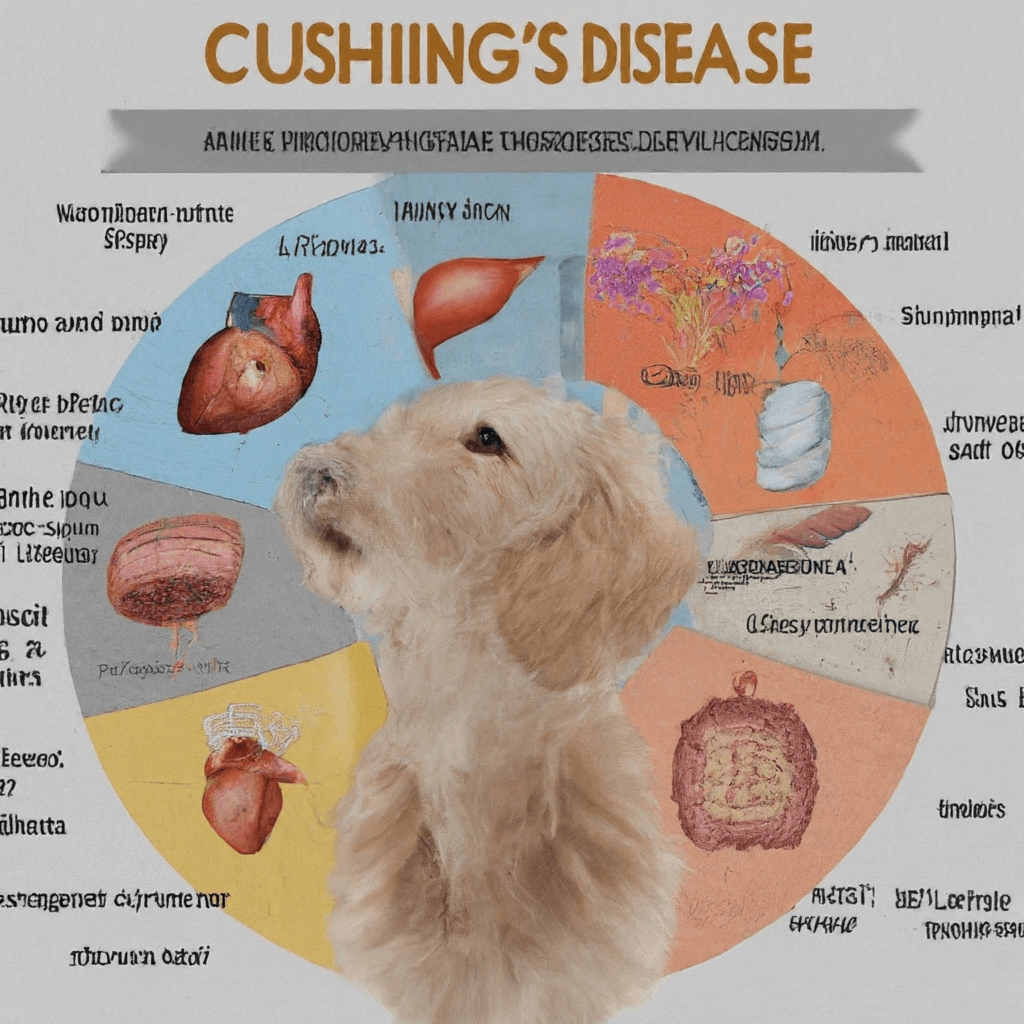Cushing’s disease, also known as hyperadrenocorticism, is a hormonal disorder affecting middle-aged and senior dogs. It occurs when the body produces an excessive amount of cortisol, a hormone involved in stress response, blood sugar regulation, and immune function. While cortisol is vital, an imbalance can lead to a cascade of health complications. This article delves into Cushing’s disease in dogs, exploring its causes, symptoms, diagnosis methods, and empowering you to recognize the initial signs in your furry companion.
Understanding the Canine Body System: A Hormone Hierarchy
To understand Cushing’s disease, let’s explore the hormonal hierarchy within a dog’s body. The pituitary gland, located at the base of the brain, acts as a central control unit, secreting various hormones, including ACTH (adrenocorticotropic hormone). ACTH then stimulates the adrenal glands, situated on top of the kidneys, to produce cortisol. Cortisol plays a multifaceted role, regulating metabolism, blood sugar levels, and the immune system.

A Breakdown of Cushing’s Disease: Two Main Culprits
There are two primary causes of Cushing’s disease in dogs:
- Pituitary-Dependent Cushing’s Disease (PDH): This is the most common form, affecting roughly 80-90% of canine cases. A tumor on the pituitary gland causes it to overproduce ACTH, which in turn, stimulates the adrenal glands to churn out excessive cortisol.
- Adrenal-Dependent Cushing’s Disease (ADH): This less frequent form (around 10-15% of cases) arises from a tumor on one or both adrenal glands, causing them to directly overproduce cortisol, bypassing the normal regulatory pathway of the pituitary gland.
Identifying the Initial Signs of Cushing’s Disease in Dogs: When to be Alert
Cushing’s disease often develops gradually, and the initial signs might be subtle. However, vigilance can help detect the condition early on, allowing for prompt treatment and improved outcomes. Here’s a breakdown of some common warning signs:
- Increased Thirst and Urination: One of the most prominent signs is excessive water consumption and urination. This occurs because the body attempts to flush out the extra cortisol through urine, leading to increased thirst to compensate for fluid loss.
- Voracious Appetite and Weight Gain: Dogs with Cushing’s often experience increased hunger despite weight gain. This is because the elevated cortisol levels stimulate appetite, while simultaneously hindering the body’s ability to utilize energy from food effectively.
- Lethargy and Weakness: The altered hormonal balance can lead to muscle weakness and fatigue, making even short walks seem daunting for your previously energetic companion.
Additional Signs to Watch Out For:
- Hair Loss and Thinning Skin: The increased cortisol disrupts the normal hair growth cycle, resulting in hair loss and a dull, fragile coat.
- Pot-Bellied Appearance: A distended abdomen, sometimes referred to as a “potbelly,” can occur due to muscle wasting and fat redistribution caused by hormonal changes.
- Recurrent Skin Infections: The compromised immune system associated with Cushing’s disease makes dogs more susceptible to skin infections.
It’s important to note that these signs can also be indicative of other health conditions. If you observe any of these in your dog, consulting a veterinarian for a proper diagnosis is crucial.
The Impact of Cushing’s Disease: A Brief Overview
Left untreated, Cushing’s disease can have a significant impact on a dog’s health and well-being. Here’s a glimpse into some potential consequences:
- Increased Susceptibility to Infections: The impaired immune system makes dogs more prone to bacterial and fungal infections.
- Diabetes Mellitus: Cushing’s disease can disrupt blood sugar regulation, potentially leading to diabetes.
- Muscle Wasting and Weakness: The disruption of protein synthesis caused by elevated cortisol levels can lead to muscle wasting and weakness.
- High Blood Pressure: Cushing’s disease can contribute to high blood pressure, putting strain on the heart and circulatory system.
- Liver and Kidney Problems: In severe cases, the altered hormonal balance can affect the liver and kidneys.

Diagnosing Cushing’s Disease in Dogs: A Multi-Step Approach
Diagnosing Cushing’s disease often involves a multi-step approach, as the initial signs can mimic other conditions. A veterinarian will typically consider your dog’s medical history, conduct a thorough physical examination, and recommend specific diagnostic tests. Here are some commonly used diagnostic techniques:
- Blood Tests: Blood tests can evaluate overall health and assess for abnormalities suggestive of Cushing’s disease.
- Urine Tests: Urine tests can measure cortisol levels and electrolyte imbalances.
- Imaging Techniques: X-rays or abdominal ultrasound scans may be used to visualize the adrenal glands and check for enlargement.
- ACTH Stimulation Test: This test measures the pituitary gland’s response to a synthetic ACTH injection. In dogs with PDH, the adrenal glands will overproduce cortisol in response to the stimulation.
- Low-Dose Dexamethasone Suppression (LDDST): This test assesses the adrenal glands’ ability to suppress cortisol production in response to a low dose of dexamethasone, a synthetic glucocorticoid. In dogs with ADH, cortisol levels will not suppress adequately.
It’s important to remember that these tests should be interpreted by a veterinarian within the context of your dog’s individual case and medical history.
Frequently Asked Questions (FAQ) about Cushing’s Disease in Dogs
- What are the treatment options for Cushing’s disease?
The treatment plan for Cushing’s disease depends on the underlying cause and severity. Common treatment options include surgery to remove a pituitary tumor (PDH), medication to suppress cortisol production, or radiation therapy to target the adrenal glands (ADH).
- Is Cushing’s disease curable?
In some cases, particularly with PDH and successful surgical removal of the pituitary tumor, Cushing’s disease can be cured. However, in other cases, lifelong management with medication may be necessary.
- What is the prognosis for dogs with Cushing’s disease?
Early diagnosis and treatment can significantly improve the prognosis for dogs with Cushing’s disease. With proper management, many dogs can live happy and fulfilling lives.
- Are certain dog breeds more prone to Cushing’s disease?
Certain breeds, such as Poodles, Yorkshire Terriers, Boxers, Boston Terriers, and Dachshunds, seem to have a higher predisposition to Cushing’s disease.
- How can I prevent Cushing’s disease in my dog?
Unfortunately, there’s no guaranteed way to prevent Cushing’s disease. However, maintaining a healthy weight for your dog and scheduling regular veterinary checkups can help with early detection and management.
Conclusion
Cushing’s disease, while a serious condition, can be effectively managed with veterinary guidance and early diagnosis. By understanding the signs, potential impacts, and diagnostic methods, you can be a vigilant pet parent and advocate for your dog’s health. Remember, early detection is key to a positive outcome. If you notice any of the signs mentioned in this article, consult your veterinarian promptly for a proper diagnosis and treatment plan.

